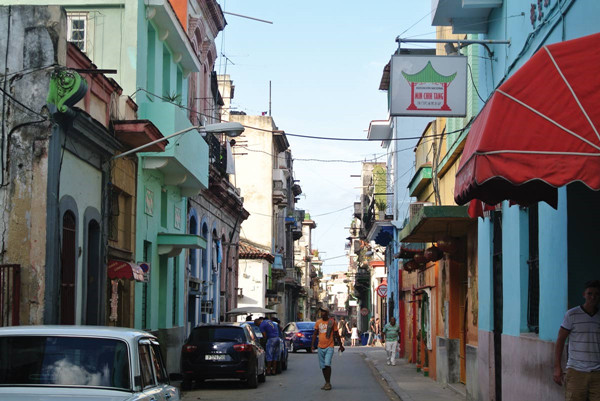
Calle Dragones, Street of the Dragons, in Chinatown, where the Min Chi Tang Associations stands
The gate of Havana’s Chinatown protrudes above a four-lane street connecting the residential neighborhood of Central Havana to the local tourist destinations. Every day of the week, vintage American cars drive past carrying foreigners on private tours of the city, or serving as rideshares for locals on their way to work.
The cement arch is written with the characters “华人街,” marking the beginning of El Barrio Chino, Chinatown. Around it, nothing visibly suggests a neighborhood for overseas Chinese—no Chinese grocery stores, or symphony of dialect in the streets. To Havana locals and the global Chinese diaspora, this neighborhood, now home primarily to Afro-Cuban residents, is a contradiction: a Chinatown without any Chinese.
But the barrio’s winding streets are still home to a small community of Chinese Cubans who reside there, or frequent the handful of Chinese associations that are the last remaining institutions of the old Chinatown, as well as leaders in the struggle to keep the neighborhood alive—one language lesson at a time.
On a Tuesday afternoon, I walk into the Havana branch of the Min Chi Tang Association, established in 1887 as a chapter of the Hongmen secret society that originated in southern China in the 18th century. The group has since become one of Chinatown’s few remaining community organizations, including clan surname associations, and historic fraternities that provide social services and recreation to an aging population of Chinese Cubans: Lunar New Year and Qingming Festival events, mahjong games and martial arts classes, as well as apartments and meals to a demographic that receives only the equivalent of 9 USD in government assistance per month, though healthcare and rent in Cuba are free.
The Min Chin Tang is also where a group of elderly women gather once a week to learn Mandarin for the first time in their lives. Today, they peer over their glasses to copy down the characters that their instructors write on the whiteboard, then tell me about the Chinatown of their childhoods. “It was one of the liveliest neighborhoods in Havana,” says María del Carmen Li Gonzales, who has been coming to Chinatown for 58 years. “Chinatown had its own music band, beauty pageants, Carnival celebrations with lion dances.” Her mother, from Cuba, and father, an immigrant from Toisan, Guangdong, used to bring her to these activities and to traditions like attending Cantonese opera—which some of the students used to perform—and weekend family dim sum at El Pacífico, one of Chinatown’s largest Chinese restaurants. “I would always have the special fried rice with shrimp, chicken, beef and Chinese sausage…my mouth is watering just describing this.”
“I won’t ever be able to have [these foods] again,” María del Carmen says, adding that today’s remaining Chinese restaurants are “different” from those in her childhood; they are usually owned by the community associations as a source of funding for their services, and cater mostly to tourists with few Chinese chefs left. The community, also, has changed: Cuba is home to fewer than 120 chinos naturales, or ethnic Chinese born in China, the youngest of whom is 72.
Officially, the Chinese have been present in Cuba for 170 years: in June, the community had celebrated the anniversary of the arrival of 206 Chinese migrant workers in 1847. Throughout the 1800s, hundreds of thousands of migrants mainly from Guangdong and Fujian provinces came to Cuba to work as “coolies,” or indentured laborers, who came to be employed in grueling and dangerous jobs on plantations, railroads, and mines around the world following the abolition of the trans-Atlantic slave trade.


















































